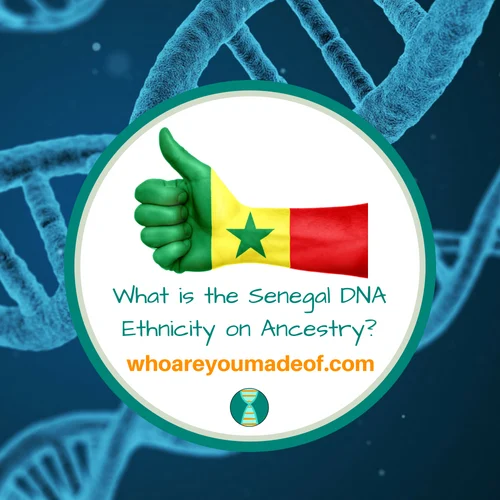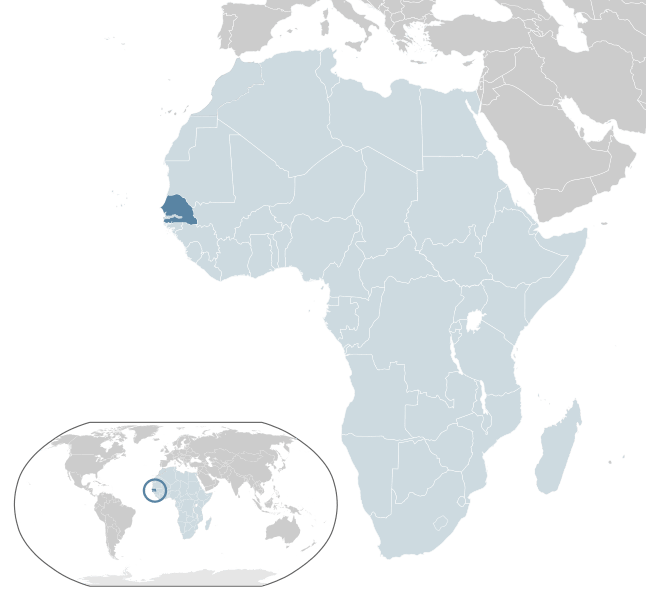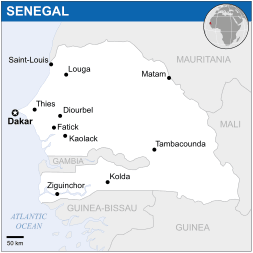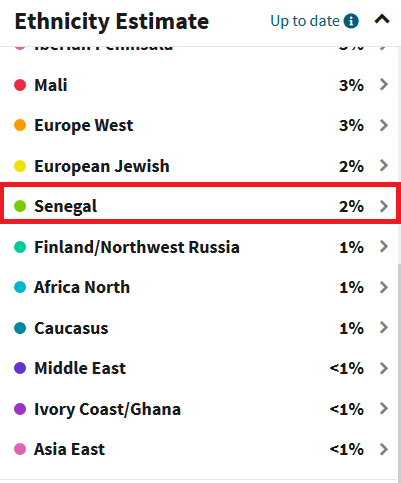Did you get the Senegal DNA ethnicity on your Ancestry DNA results? If you are like most people, you are curious about the Senegal DNA ethnicity and want to learn more about how you might have inherited it, and you have come to the right place.
In this post, you'll learn:
- Where the Senegal DNA ethnicity is located
- Which countries are included in the Senegal DNA region on Ancestry
- How far back your Senegalese ancestor might be, based on your ethnicity percentage
- How you might have inherited your Senegal DNA

My daughter's father is from the Costa Chica region of Mexico, where many people have a beautiful mixture of African, indigenous Native American, and European ancestry.
One of the DNA regions that showed up on her Ancestry results was Senegal (shown in the image below), which we found very interesting. Tracing family history in Mexico presents unique challenges, but we are using all of the tools at our disposal, including DNA.
Cool Senegal fact: Did you know that the official language of Senegal is French? There are several other languages spoken in Senegal, too, including Wolof, Pulaar, Jola, and Mandinka.
Where is the Senegal DNA ethnicity region located?

The Senegal DNA region is located on the western coast of Africa - the part that juts out into the Atlantic Ocean, as seen in the image above. On the map, Senegal is highlighted in blue.
The area that corresponds to the Senegal DNA region is a little larger than the political boundaries of Senegal, and includes parts of the neighboring countries.
The image below, which is of the country of Senegal, shows parts of Mauritania, Mali, Guinea, Guinea-Bissau, plus the entire country of The Gambia. This area is basically the Senegal DNA ethnicity region, as defined by Ancestry DNA.

Which countries are included in the Senegal DNA region?
According to Ancestry DNA, the Senegal DNA region generally covers:
- Senegal
- The Gambia
Sometimes, Senegalese DNA can be found in the following nearby regions:
- Gineau-Bissau
- Gineau
- Mali
- Mauritania
Do people in the Senegal DNA region typically have DNA from other places?
People have been living in the Senegal DNA region for hundreds of thousands of years, which has been demonstrated by evidence found at archeological digs surrounding the Falémé River in Senegal.
In the past two thousand years, Senegal (and the surrounding DNA region) has found itself under the control of various empires, including the Takrur, Jolof, and the Ghana Empire. In modern times, Senegal was a colony of France, finding itself under the political and military control of that European country until it achieved full independence in 1960.
According to Ancestry DNA's data, the average person from the Senegal DNA region will have between 80-100% Senegal DNA. People who do show DNA from other regions typically have DNA from the Mali and The Gambia ethnicity regions.
Even though most people who live in the Senegal DNA region will have low percentages of DNA from outside regions, 46% of people living in the Senegal DNA region will show at least some DNA from Mali.
Check this out: I bet you didn't know that Senegal has more than one thousand stone circles (reminiscent of those found at Stonehenge, yet much more extensive!)
How far back is my Senegalese Ancestor?
You might be wondering if you can use your percentage of Senegal DNA in order to determine how far back your ancestor might be. Sometimes, those of us in the DNA genealogy circles refer to this ancestor as our "100% ancestor".
It's true that sometimes you might be able to get a rough idea as to how far back in your family tree you need to look in order to find your Senegalese ancestor, especially if you think that you have a relatively recent Senegalese immigrant ancestor.
- A basic rule of thumb for this method would be that if you have 25% Senegal DNA, then one of your parents might have been 50%, and therefore, one of your grandparents had 100% Senegal DNA.
There are a few major problems with using this method to figure out where to look for your Senegal DNA:
- Ethnicity regions (as seen in our autosomal DNA) doesn't get passed down in equal 50% portions each generation, meaning that if your parent had 50% Senegal DNA, you could have inherited anywhere from 0-50% Senegal DNA. We inherit 50% of each of our parent's DNA, but there is no way to know which 50% we'll get.
- You might have ancestors on more than one side of your family that passed down their Senegal DNA ethnicity to you
- Even if you have a known ancestor from Senegal, they might not have had 100% Senegal DNA
How did I get Senegal in my DNA Results?
It can be difficult to determine from whom you in inherited your Senegal DNA. Depending on where your parents, grandparents, and great-grandparents were born, you'll know which direction you might need to look to find the answer.
Below, I'll describe a few situations - by no means a comprehensive list - as to how many people who live in the United States may have inherited their Senegalese ancestry.
Senegal DNA in the United States
Many Americans with Senegal DNA inherited this ancestry through ancestors who were captured in their homeland and sold into slavery in North and South America.
More than 10 million individuals from Africa suffered this tragic fate, and many of them were from Senegal, The Gambia, and the surrounding areas. There has also been substantial voluntary immigration from Senegal to the United States, especially during the past 100 years.
Senegal DNA in Mexico
Just as in the United States, there were also enslaved individuals who were forcefully displaced to other countries, like Mexico. Many Mexicans have Africa ancestry, although it is often unknown and not commonly discussed.
If you have ancestors from Mexico, especially from states like Guerrero, Oaxaca, and Veracruz, it's possible that you could have inherited your Senegal DNA from people who were enslaved and brought to Mexico.
Did you know? The island of Gorée, located off the coast of Senegal across from Dakar, is well-known as the center of a large portion of the trans-Atlantic slave trade. For about four hundred years, the island was used as a port for the tragic and horrific exportation of enslaved humans from the continent of Africa.
This practice was outlawed by the French colonizers before 1850, and the island now serves as a tourist destination for those interested in learning about the slave trade, remembering the lives of millions of Africans who died during the middle passage, and those who survived only to be enslaved in North and South America.
Can I Trace My Senegal Ancestry?
If you have Senegalese ancestry, it's possible that in certain cases you might be able to find some records pertaining to your family tree. You'll have better luck if your Senegal ancestors are recent immigrants to the US (or other country), or if you believe that your Senegal ancestor was born in Senegal after about 1730.
It might come as a surprise to some, but there are actually both church and civil records have been kept for Senegal for hundreds of years, and while they don't cover the full population, you still might find helpful information.
If you go back only eight generations in your family tree, you'll notice that you have hundreds of ancestors. Go back three more generations, and you'll find that you have thousands of ancestors. My point is that if you can find out who your Senegales ancestor(s) was (were), then it is worth a look to see if you can learn about where they came from.
How thorough are genealogical records in Senegal?
- Civil records (kept by the government) are estimated to cover almost all of the British and French colonial residents, and about 50% of the Senegalese/Gambian residents
- Christian church records generally cover about 85% of the British and French colonial residents, and only about 20% of the Senegalese/Gambian residents, since Islam has grown in Senegal since colonization, and people still practiced traditional African religions (some still do)
The best way to figure out how much you'll be able to learn about your distant Senegal roots is to start with more recent ancestors - your parents. Figure out where your parents, grandparents, and great-grandparents were born. Talk to your older relatives (take notes!) and see what you can learn. Basically, build a family tree.
Conclusion
I hope that this post helped you understand a little bit about Senegal's geography, rich cultural history, and your DNA results. If you have any questions about something that you read in this post, or would like to share your experience tracing your Senegalese DNA, I would love to hear from you in the discussion below.
Thanks for stopping by!



Sunny Ludvik
Tuesday 27th of June 2023
I know that my Senegal DNA came from my dad's family, the Olds family. A complete (at the time) genealogy of the family was done in 1909. My Mom added to it as we grew up. Evidently, someone along the way failed to mention the family' that might have come from the slaves that came from Africa.
Laura
Friday 8th of October 2021
How is it that I have 1% Senegal in my Ancestory results but my sister by the same parents does not?
Nancy
Tuesday 25th of May 2021
I was surprised to get 1% Senegal dna.